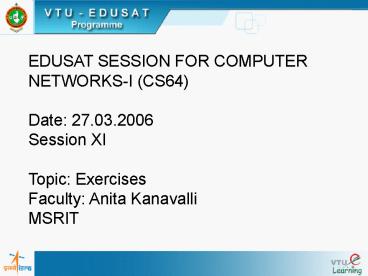EDUSAT SESSION FOR COMPUTER NETWORKSI CS64 - PowerPoint PPT Presentation
1 / 20
Title:
EDUSAT SESSION FOR COMPUTER NETWORKSI CS64
Description:
What we have learnt so far? Chapter 1: Computer Network definition ... FDDI. Wireless LAN. Bridges. Switches. VLANs. Exercises ... – PowerPoint PPT presentation
Number of Views:78
Avg rating:3.0/5.0
Title: EDUSAT SESSION FOR COMPUTER NETWORKSI CS64
1
EDUSAT SESSION FOR COMPUTER NETWORKS-I
(CS64) Date 27.03.2006 Session XI Topic
Exercises Faculty Anita Kanavalli MSRIT
2
What we have learnt so far?
- Chapter 1 Computer Network definition
- Classification computer netwotk
- Different topologies of computer network
- protocol and primitives
- layered structures-OSI model
- uses of computer network
- Chapter 2
- Ethernet
- Token ring
3
What we have learnt so far?
- FDDI
- Wireless LAN
- Bridges
- Switches
- VLANs
4
Exercises
1 Consider building a CSMA/CD network running at
1 Gbps over a 1-km cable with no repeaters. The
signal speed in the cable is 200,000 km/s. What
is the minimum frame size? Answer The cable
length 1-km, the signal can travel up to 1-km -
before a collision occurs. The effect of the
collision would then have to travel a further
1-km - back to the transmitting station to be
detected. There fore it takes
2/20000010microsec. In 10microsec a 1 Gbps
transmitter will send 109 bits/sec10microsec10,
000 bits or 1250 bytes, which is thus the minimum
frame size.
5
Exercises
2 A token ring network that operates at a speed
of 4Mbps with 30 stations separated by 50 mts.
The interface delay b is 2.5 bits. Determine the
efficiency of the ring if the frame size is 500
bits and the token reinsertion is done after the
frame returns fully. Answer Given R4Mbps M30
b2.5 and v2108 The ring latency in bits is
given by dR/vMb bits (30504106 /2108)
302.5 78bits
6
Exercises
At t0 station starts transmitting a frame At
t78 the first bit arrives At t500 the last bit
transmitted At t50078578 the last bit arrives
back to source the station reinserts the
token Therefore the ring efficiency is
500/57886
7
Exercises
3 Suppose that a group of 10 stations is
serviced by an Ethernet LAN. How much bandwidth
is available to each station if (a) the 10
stations are connected to a 10 Mbps Ethernet hub
(b) the 10 stations are connected to a 100 Mbps
Ethernet hub (c) the 10 stations are connected
to a 10 Mbps Ethernet switch.
8
Exercises
Answer a. Assuming 100 efficiency, the 10 Mbps
are shared equally by the 10 stations. b.
Assuming 100 efficiency, the 100 Mbps are shared
equally by the 10 stations. c. Each station has
nearly 10 Mbps to the Ethernet switch. Each
station has full access to the 10 Mbps if the
switch capacity can handle the aggregate rate
from all the stations.
9
Exercises
4 Use IEEE 802.3 and IEEE 802.11 to discuss
three differences between wired and wireless
LANs. Answer Error rate wireless LANs have high
error rate due to interference and noise.
Wireless LANs needs to implement ARQ and error
correction to increase the reliability of the
communication channel compared to wired
LANs Station mobility in wired LANs stations
connected to the LANs are static, in wireless
LANs, the stations can be mobile and portable.
Wireless LAN protocols may have to implement
dynamic traffic routing and service handoff when
the station moves from one area to another
10
Exercises
Answer Collision detection Collision detection
is not possible in wireless LANs due to physical
limitations. So the sender must wait for explicit
acknowledgment (e.g. RTS/CTS) from the receiver
to know whether or not a collision has occurred.
The wireless LAN protocol implements a collision
avoidance algorithm rather than the collision
detection in wired LAN, and the delay in the
contention period is longer the round-trip delay
of 2tprop of wired LAN because of waiting for the
receivers acknowledgment.
11
Exercises
Answer Security In wired LAN, the transmission
medium is physically secured. In wireless LAN,
any device within the geographic transmission
area can intercept the transmissions. To provide
data security, wireless LAN need to implement
encryption at the expense of higher cost and
reduced performance. Power consumption Portable
and mobile devices are usually battery powered,
and thus have limited power capacity. The
wireless LAN protocol must be designed to be
power efficient. All these issues are addressed
in the IEEE 802.11 wireless LAN protocol.
12
Exercises
5 Six stations (S1-S6) are connected to an
extended LAN through transparent bridges (B1 and
B2), as shown in the figure below. Initially, the
forwarding tables are empty. Suppose the
following stations transmit frames S2 transmits
to S1, S5 tsransmits to S4, S3 transmits to S5,
S1 transmits to S2, and S6 transmits to S5. Fill
in the forwarding tables with appropriate entries
after the frames have been completely
transmitted.
13
Exercises
14
Exercises-solution
15
Exercises
6 What is meant by 10BaseT? What are the three
approaches to operate a LAN on a star
topology? 7 Explain CSMA/CA protocol 8 The LANs
in the figure below are interconnected using
source routing bridges. Assume that bridges 3 and
4 are not part of the initial spanning tree.
16
Exercises
17
Exercises
18
Exercises-all route
19
Exercises
20
Exercises
9 Briefly describe Service primitives Multicastin
g SAP 10 Illustrate with the diagram the layered
architecture and show how communication takes
place in the computer network































